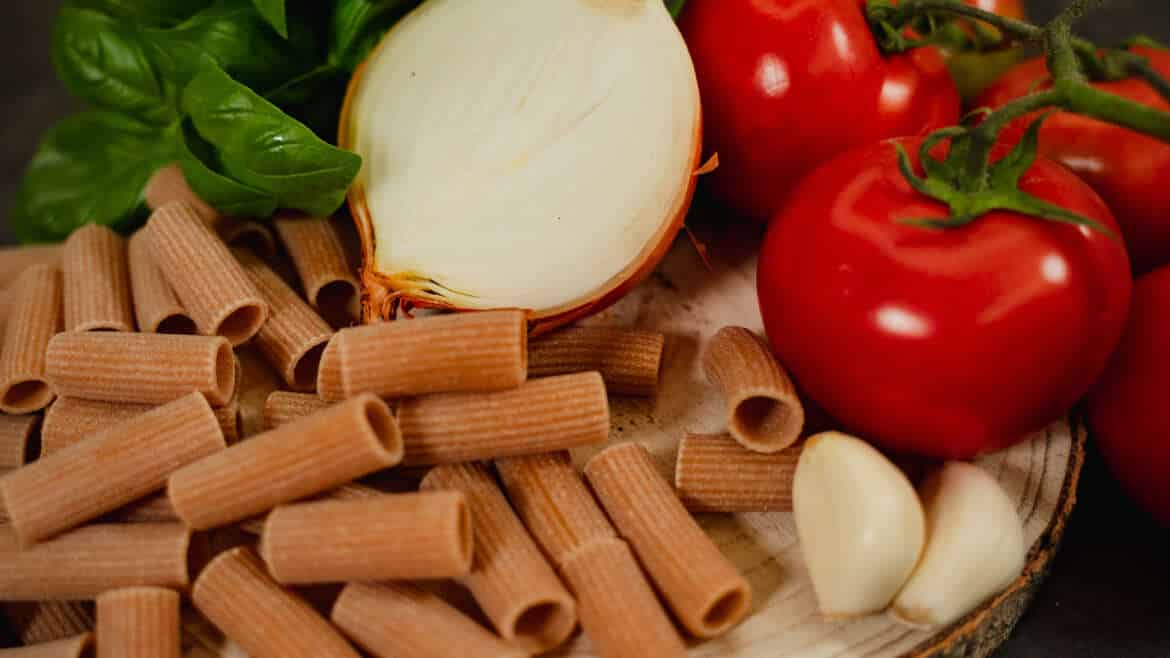Pasta with tomato sauce might seem like the easiest recipe in the world, but there are quite a few pitfalls involved in making it.
Pasta with tomato is the most traditional, satisfying, and seemingly simple dish in Italian cuisine.
Indeed, despite requiring only a few ingredients (and few calories, around 400 for 80 grams of pasta) to prepare it, to make it perfectly, one must have an in-depth understanding of pasta and tomatoes’ characteristics, along with the secrets to enhance the dish’s success.
How do you achieve a good tomato pasta?
First and foremost, with high-quality ingredients.
In addition to good tomatoes, Italian extra virgin olive oil, a little unpeeled garlic to release a subtle but not overly persistent fragrance, a bit of onion to sweeten tomatoes with a slightly more acidic taste, such as San Marzano, and a few basil leaves. Nothing else.
What color should a good sauce be? A vibrant, bright red, like that of San Marzano. It should never be too dark or too light; otherwise, it may indicate that the tomato is not of high enough quality.
And how long should it cook? There are tomato varieties that we should cook very briefly to avoid depleting the sauce of their aroma and fragrance: just three minutes in a hot pan is enough. But for San Marzano, which is the most common for tomato sauce, we suggest a long cooking time, up to two or three hours, because it is a very watery tomato.
On pasta packages, there are often two types of cooking indications: “cooking time” or “al dente.“
These are just general guidelines: pasta is a natural product, and sometimes, there are batches from the same brand and format that are more or less dried.
We believe the best way to ensure proper cooking is to add a few extra grams of pasta and taste it to adjust according to your taste.
The most recommended formats and those to avoid? We suggest spaghetti, or at least ridged pasta, which ‘holds’ the sauce better.
If you choose spaghetti, you can aspect more substance and a consistent texture because they are more consistent in cooking.
It depends on your preferences but we wouldn’t use mixed pasta or very short and small pasta, which is more suitable for soups.
Can a good pasta also be made with whole wheat pasta?
“Yes, of course. It’s a very flavorful pasta that pairs well with the Mediterranean aromas of tomatoes, basil, garlic, and onions.”
Is it better to use canned tomatoes, tomato passata, or fresh tomatoes?
If the season allows, fresh tomatoes are always better. But since they are not available year-round, you can also use canned tomatoes, provided they are of high quality.
Better if they are made the traditional way, like when fresh tomatoes were harvested in the summer and then preserved, pasteurized, in glass containers.
For those who buy canned tomatoes at the supermarket, how should they choose them?
Don’t think you can get a quality product for a low price: stay away from very commercial brands and multinational corporations, prefer canned products made by local companies that collaborate with small producers.
Tomato sauce: common mistakes that are easy to make
- Adding too much garlic or letting it burn.
- Using too much oil.
- Adding too little water to the pot (the right amount is 5 liters of water for one kilo of pasta).
- Overcooking the tomato: it should retain its fragrance.
And if you forget to salt the water? There’s not much you can do: pasta absorbs coarse salt from salted water through osmosis. If you add it after cooking, the pasta will continue to be unsalted, while the sauce will become overly salty.
Do you need a bit of sugar in the sauce to “reduce acidity”?
“No, if you use excellent tomatoes, the sauce will never be too acidic. If you want to make it sweeter, it’s better to add some onions, but a slight acidity is also pleasant—it’s part of the natural taste of tomatoes. Always respect the raw material.”
A chef’s secret?
Here are some useful tips to try and make your own:
- If you like your tomato sauce with onion, choose a small onion, add little garlic and extra virgin olive oil. Brown very well.
But the little extra secret is the addition of high-quality tomato paste, to be cooked together with the mixture until it turns rust coloured. And only then are added fresh tomatoes if in season or organic peeled tomatoes. Another secret: add salt to the sauce immediately, so that the tomatoes immediately release their liquid and flavour, then leave to cook for an hour. Last trick: the puree is made only when the mixture is cold, so that the color remains intense and more concentrate is added at the end to give a nice velvetiness to the sauce. - The most important thing is to choose ripe tomatoes in season and to have a good dose of flavor and low acidity.
- Another option is to prepare separately a sauté of onion and garlic and only after that add the tomatoes that you have cut separately and cooked slowly with just a little salt. Finally, adjust the sauce with sugar and bicarbonate of soda to lower the acidity. Eventually season everything with lots of basil.
To put all these tips into practice and combine the best tomato sauce with homemade pasta, take part in one of our cooking classes!

